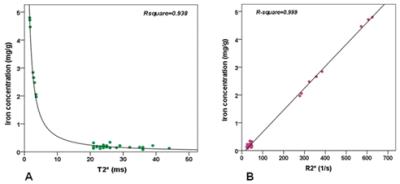3110
Biopsy-based calibration of T2* magnetic resonance for estimation of liver iron concentration1Fondazione G. Monasterio CNR-Regione Toscana, Pisa, Italy, 2Ospedale "V. Cervello", Palermo, Italy
Synopsis
An excellent linear agreement between R2* values and cardiac iron measured with emission spectroscopy was found. The results further validate the current clinical practice of monitoring cardiac iron in vivo by CMR.
Purpose
The measurement of myocardial iron by T2* CMR has been established as fundamental to the best practice management of thalassemia.1 However, iron calibration data in humans is limited2 and CMR calibration varies according to instrumentation and technique.
The aim of this study was to calibrate the T2*-CMR technique for noninvasive cardiac iron assessment, by considering a segmental approach.
Methods
Four human hearts were studied from transfusion-dependent patients after their death within the MIOT network (Myocardial Iron Overload in Thalassemia).3 A multislice multiecho T2* approach was adopted.4 After CMR, used as guidance, the heart was cut in three short-axis slice and each slice was cut into different equiangular segments, the same ones in which the T2* was assessed. Tissue iron concentration in the segments was measured with inductively coupled plasma atomic emission spectroscopy.Results
T2* and iron concentration were overall assessed in 36 myocardial segments: 6 in the first heart (year 2004), 6 in the second one (year 2004), 8 in the third one (year 2005), and 16 in the fourth one (year 2010).
Figure 1A shows the segmental iron concentration (in milligrams per gram dry weight) plotted versus the correspondent segmental T2* value (in milliseconds). As expected, the relationship was not linear. In Figure 1B the R2* values (R2*=1000/T2*, in s-1) were considered. Regression analysis yielded a linear calibration of the following form: [Fe]R2* =0 .0079 × R2* - 0.1262 (R-square=0.999).
Conclusion
As in the only previously proposed calibration curve by Carpenter et al,2 we did not collected hearts with an intermediate iron burden.
We found an excellent linear agreement between R2* and cardiac iron with a model similar to the calibration curve in the gerbil showed by Wood et al.5 The results further validate the current clinical practice of monitoring cardiac iron in vivo by CMR.
Acknowledgements
No acknowledgement found.References
1. Pennell DJ. T2* magnetic resonance: iron and gold. JACC Cardiovasc Imaging. 2008;1(5):579-581.
2. Carpenter JP, He T, Kirk P, et al. On T2* magnetic resonance and cardiac iron. Circulation. 2011;123(14):1519-1528.
3. Meloni A, Ramazzotti A, Positano V, et al. Evaluation of a web-based network for reproducible T2* MRI assessment of iron overload in thalassemia. Int J Med Inform. 2009;78(8):503-512.
4. Pepe A, Positano V, Santarelli F, et al. Multislice multiecho T2* cardiovascular magnetic resonance for detection of the heterogeneous distribution of myocardial iron overload. J Magn Reson Imaging. 2006;23(5):662-668.
5. Wood JC, Otto-Duessel M, Aguilar M, et al. Cardiac iron determines cardiac T2*, T2, and T1 in the gerbil model of iron cardiomyopathy. Circulation. 2005;112(4):535-543.
